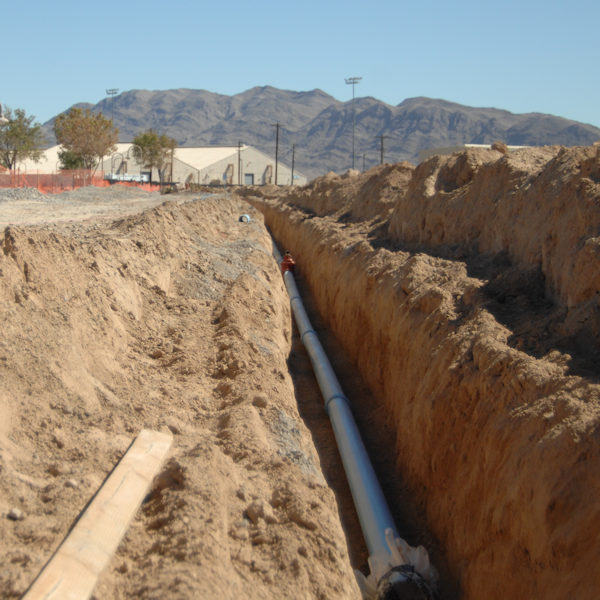Benching Systems
There are two basic types of benching: simple and multiple. The type of soil determines the horizontal to vertical ratio of the benched side.
- As a general rule, the bottom vertical height of the trench must not exceed 4 feet. However, subsequent benches may be up to a maximum of 5 feet vertical in Type A soil and 4 feet in Type B soil.
- All subsequent benches must be below the maximum slope allowed for that soil type.
- In Type B soil, the trench excavation is permitted only in cohesive soil.
Definitions
- Actual slope - the slope to which an excavation face is excavated.
- Distress - the soil is in a condition where a cave-in is imminent or is likely to occur. Distress is evidenced by such phenomena as the development of fissures in the face of or adjacent to an open excavation; the subsidence of the edge of an excavation; the slumping of material from the face or the bulging or heaving of material from the bottom of an excavation; the spalling of material from the face of an excavation; and ravelling, i.e., small amounts of material such as pebbles or little clumps of material suddenly separating from the face of an excavation and trickling or rolling down into the excavation.
- Maximum allowable slope - the steepest incline of an excavation face that is acceptable for the most favorable site conditions as protection against cave-ins, and is expressed as the ratio of horizontal distance to vertical rise (H:V).
- Short term exposure - a period of time less than or equal to 24 hours that an excavation is open.






Requirements
Soil classification. Soil and rock deposits shall be classified in accordance with appendix A to subpart P of part 1926.
Maximum allowable slope. The maximum allowable slope for a soil or rock deposit shall be determined from Table B-1 of this appendix.
Actual slope. The actual slope shall not be steeper than the maximum allowable slope. The actual slope shall be less steep than the maximum allowable slope, when there are signs of distress. If that situation occurs, the slope shall be cut back to an actual slope which is at least ½ horizontal to one vertical (½H:1V) less steep than the maximum allowable slope.
When surcharge loads from stored material or equipment, operating equipment, or traffic are present, a competent person shall determine the degree to which the actual slope must be reduced below the maximum allowable slope, and shall assure that such reduction is achieved. Surcharge loads from adjacent structures shall be evaluated in accordance with 1926.651(i).
Configurations. Configurations of sloping and benching systems shall be in accordance with Figure B-1.
MAXIMUM ALLOWABLE SLOPES
| SOIL OR ROCK TYPE | MAXIMUM ALLOWABLE SLOPES (H:V)(1) FOR EXCAVATIONS LESS THAN 20 FEET DEEP(3) |
|
STABLE ROCK TYPE A (2) TYPE B TYPE C |
VERTICAL (90 degrees) 3/4:1 (53 degrees) 1:1 (45 degrees) 1:1 (34 degrees) |
Footnote(1) Numbers shown in parentheses next to maximum allowable slopes are angles expressed in degrees from the horizontal. Angles have been rounded off.
Footnote(2) A short-term maximum allowable slope of 1/2H:1V (63 degrees) is allowed in excavations in Type A soil that are 12 feet (3.67 m) or less in depth. Short-term maximum allowable slopes for excavations greater than 12 feet (3.67 m) in depth shall be 3/4H:1V (53 degrees).
Footnote(3) Sloping or benching for excavations greater than 20 feet deep shall be designed by a registered professional engineer.
See Appendix B for detailed slope configurations.
Knowledge Check Choose the best answer for the question.
4-3. As a general rule, the bottom bench vertical height of a multiple-benched trench must not exceed _____.
You forgot to answer the question!

